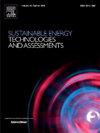A comprehensive review of two decades of research on agrivoltaics, a promising new method for electricity and food production
IF 7.1
2区 工程技术
Q1 ENERGY & FUELS
Sustainable Energy Technologies and Assessments
Pub Date : 2024-10-28
DOI:10.1016/j.seta.2024.104055
引用次数: 0
Abstract
An agrivoltaic system combines energy production and agricultural crops in one location, addressing the growing demand for sustainable and cost-effective energy sources. The objectives of this bibliometric analysis are to identify knowledge gaps, emphasize important contributions, and highlight trends in agrivoltaic research. It is expected to support creative research in agriculture and sustainable energy, foster collaborations, and inform decision-making. This study thus employed the systematic, bibliometric and content analysis review approach to analyse research works published on the topic during the last two decades. Data from the Scopus database was used for the qualitative and quantitative analysis using the Biblioshiny package in R and VOSviewer software. The study analysed 155 documents, revealing an 18.21% annual growth in research on agrivoltaics. The most frequently used keyword was agrivoltaics, highlighting its potential for sustainability and sustainable land use. Research on the topic is found to be evolving from small-scale irrigation power generation to large-scale electricity generation, emphasizing dual land use for energy and food production. North Carolina State University and Chinese institutions are leading in agrivoltaics research. The study concluded with some identified research gaps that should be examined going into the future.
全面回顾二十年来有关农业光伏技术的研究,这是一种前景广阔的电力和食品生产新方法
农业光伏系统将能源生产和农作物种植结合在一起,满足了人们对可持续和具有成本效益的能源日益增长的需求。这项文献计量分析的目的是找出知识差距,强调重要贡献,并突出农业光伏研究的趋势。它有望为农业和可持续能源领域的创造性研究提供支持,促进合作,并为决策提供信息。因此,本研究采用了系统性、文献计量学和内容分析的综述方法,对过去二十年间发表的有关该主题的研究著作进行了分析。使用 R 中的 Biblioshiny 软件包和 VOSviewer 软件对 Scopus 数据库中的数据进行了定性和定量分析。研究分析了 155 篇文献,发现有关农业光伏的研究每年增长 18.21%。使用频率最高的关键词是农业光伏,突出了其在可持续性和可持续土地利用方面的潜力。研究发现,有关这一主题的研究正在从小规模灌溉发电向大规模发电发展,强调能源和粮食生产的双重土地利用。北卡罗来纳州立大学和中国机构在农业光伏研究方面处于领先地位。研究报告最后指出了未来应研究的一些研究空白。
本文章由计算机程序翻译,如有差异,请以英文原文为准。
求助全文
约1分钟内获得全文
求助全文
来源期刊

Sustainable Energy Technologies and Assessments
Energy-Renewable Energy, Sustainability and the Environment
CiteScore
12.70
自引率
12.50%
发文量
1091
期刊介绍:
Encouraging a transition to a sustainable energy future is imperative for our world. Technologies that enable this shift in various sectors like transportation, heating, and power systems are of utmost importance. Sustainable Energy Technologies and Assessments welcomes papers focusing on a range of aspects and levels of technological advancements in energy generation and utilization. The aim is to reduce the negative environmental impact associated with energy production and consumption, spanning from laboratory experiments to real-world applications in the commercial sector.
 求助内容:
求助内容: 应助结果提醒方式:
应助结果提醒方式:


